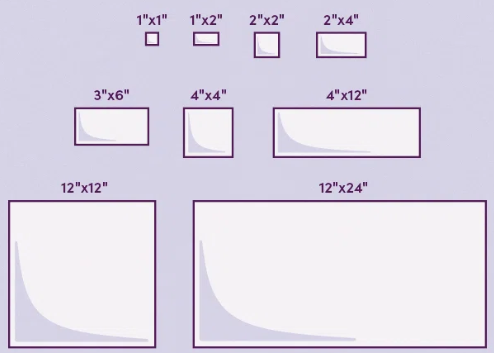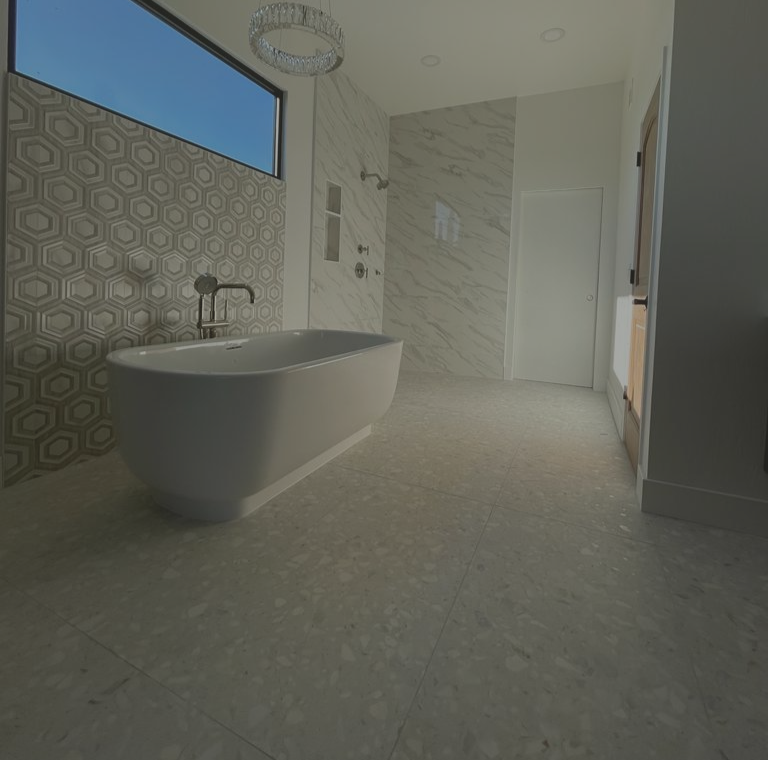A Guide To Help You Choose The Best Tile Size.
Floors, Walls, Showers, and Small Bathrooms
Note:
Some contents in this article may contain external links. For more information, please refer to our
Privacy Policy
Ceramic tile offers great flexibility when it comes to bathroom design. With a wide range of sizes available, from small mosaic tiles measuring 1/2-inch square to large format tiles as big as 30 inches by 15 inches, you have numerous options for your bathroom flooring, walls, and shower and bathtub surrounds.
However, it’s important to note that not all tile sizes are suitable for every application. For instance, large-format tiles may appear awkward and out of place in small bathrooms. To achieve a visually pleasing result, you’ll need a sufficient number of full-size tiles, which may not be feasible in a limited space. In such cases, many tiles would have to be cut to fit.
Nevertheless, it’s worth mentioning that bathroom tile sizing is not set in stone, and the sizes suggested in this guide are merely recommendations, not strict rules. Feel free to experiment with different tile sizes to find the best fit for your personal taste. In small bathrooms, you can easily dry-fit most of the tiles to get an idea of how they will look once installed.
| Area | Recommended Sizes |
|---|---|
| Small shower floor pan | 1-inch square |
| Small shower walls | 1-inch square to 4-inch square |
| Moderate or large shower walls | 4-inch to 15-inch by 30-inch |
| Bathroom floor | 1-inch square to 12-inch square, or up to large-format for large bathrooms |
| Bathroom walls | 4-inch square up to 12-inch by 24-inch |
Shower Floor and Wall Tile Size
When it comes to shower floors or pans, it is generally recommended to use smaller tiles ranging from 4 inches by 4 inches down to 1-inch by 1-inch mosaic tiles. The reason behind this is to ensure that the tile installer can create gentle contours while laying the mortar bed. These contours are essential for proper water drainage towards a centrally located drain.
In addition to facilitating proper drainage, smaller tiles also offer better grip for bare feet on shower flooring. By using smaller tiles, the installer needs to include more seams between the tiles, resulting in a greater amount of grout being laid. These grout lines can provide the necessary friction when walking on wet flooring, ensuring better stability.
Shower Wall Tile Size
When it comes to shower walls of moderate to large size, it is generally recommended to opt for larger tiles. These can range from 4-inch by 4-inch tiles to larger format tiles measuring 15 inches by 30 inches.
From an aesthetic perspective, using tiles smaller than 4 inches square can create a cluttered appearance. Moreover, smaller tiles are more challenging to clean. With more seams, there is an increased amount of grout, which adds to the cleaning effort.
For alcove bathtubs, large-format tiles up to 30 inches in length are usually the maximum size that can be used, as these spaces are typically limited to 60 inches in length. If larger tiles were to be used, they would need to be cut to fit the space. It is more convenient and cost-effective to purchase tiles that perfectly match the dimensions of the area.
What Size of Tile for a Small Bathroom Shower?
Small bathroom showers, use 1-inch mosaic tile for shower floor. For the walls, keep the tile in the 1-inch square to 4-inch square range.
Bathroom Wall Tile Size
Bathroom walls, much like shower walls, tend to have a more appealing appearance when adorned with tiles larger than 4 inches by 4 inches. Given that bathroom walls can be wider than they are tall, it is advisable to opt for tiles that are longer in length. If you prefer larger tiles, tiles measuring 12 inches in height and 24 inches in length are a suitable choice.
In addition to this, subway tiles are a popular choice for bathroom walls due to their 1:2 size ratio. For those seeking elongated yet narrow ceramic tiles, listellos can be considered. These decorative tiles are often utilized to demarcate two distinct sections of wall tiles.
Bathroom Floor Tile Size
Bathroom tile flooring offers a wide range of options when it comes to tile sizes, ranging from mosaic to large format tiles. It is important to consider the level of friction as well. The coefficient of friction (COF) ratings for each tile can be found in the printed and online literature provided by tile manufacturers.
For bathroom floors, conventional 12-inch by 12-inch tiles are commonly used because they are easy to cut using wet tile saws or rail tile cutters. Additionally, this size of tile ensures that even in the smallest bathrooms, you will have a sufficient number of full-size tiles. Another visually appealing option for small bathrooms and powder rooms is 4-inch by 4-inch tiles.
If you prefer to have large format tiles in your bathroom, it is advisable to calculate the square footage of your bathroom. This will help you determine the number of full-size tiles required.
A suitable layout for large format tiles in a small bathroom could be four tiles placed vertically along the length of the bathroom and three tiles placed horizontally across the width. It is important to avoid having less than three tiles across the width as it can create an awkward look, especially if you need to cut any of these tiles.

How to Find Slip-Resistant Tile for Bathroom Flooring
In order to prevent slips and falls in bathrooms, it is crucial to take necessary precautions. The combination of water and bare feet, along with the often hurried mornings, can lead to dangerous accidents.
One popular choice for bathroom flooring is mosaic tile, as it offers superior grip for both wet and dry feet due to its seaming. However, is there an alternative method to ensure that the bathroom floor tile is slip-resistant?
The slip resistance of a surface is measured by its coefficient of friction (COF), which is a standard rating used in various applications. In the porcelain and ceramic tile industry, COF is also used to determine the safety of floor tiles.
Most tile manufacturers provide COF ratings for their floor tiles. Higher COF ratings indicate better slip resistance, while lower numbers are less desirable. For example, a COF rating between 0.3 and 0.6 signifies a clean and dry surface. Some slippery surfaces may have a COF rating as low as 0.04. It is important to note that a tile cannot have a COF rating of zero, as this would mean there is no friction at all.
For further assistance on how to the different types of Hardwood Flooring or Engineered Wood Flooring, or general questions regarding flooring, our team of flooring experts is readily available to address your inquiries and provide tailored recommendations to meet your specific requirements. Give a call at 623-305-4390 or click here.
Share This Article

